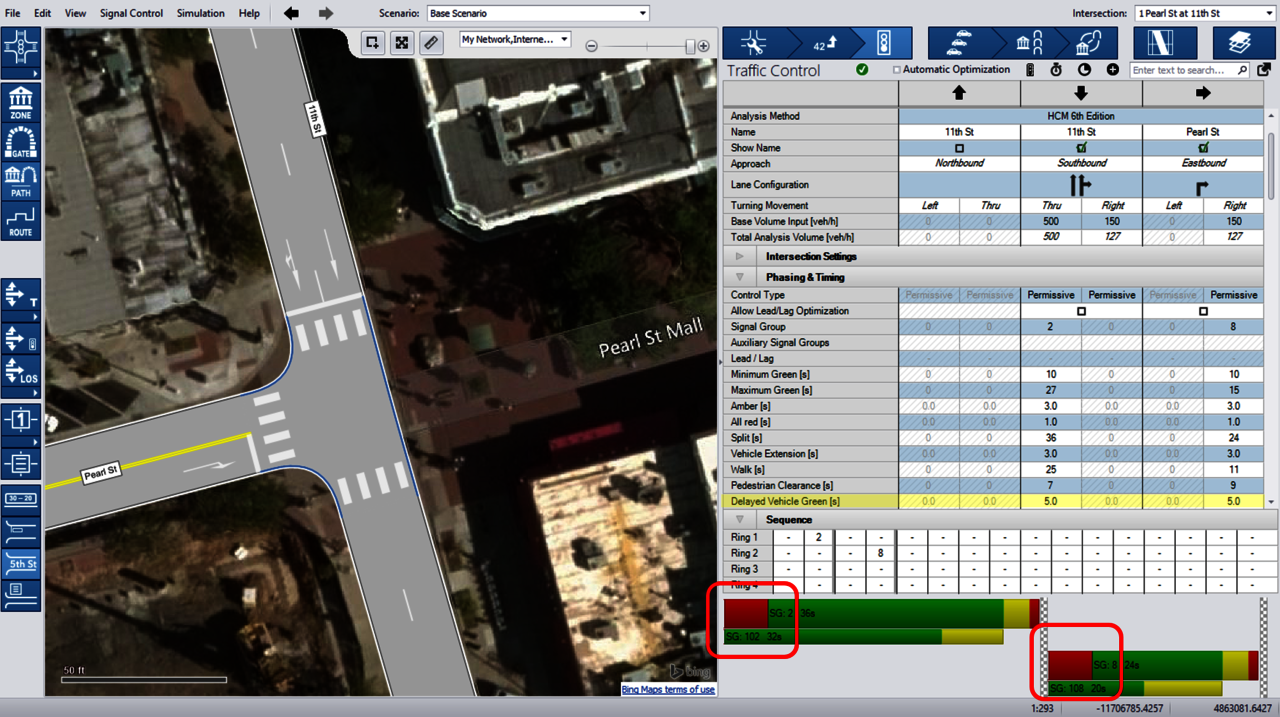PTV Vistro embraces pedestrian safety goals with the new Leading Pedestrian Interval feature
The new Delayed Vehicle Green functionality is available in PTV Vistro 2020. This feature enables you to easily evaluate Leading Pedestrian Intervals at one or multiple intersections in a coordinated traffic signal system. The addition of this feature comes at a critical time, as cities are promoting walkability, but are faced with climbs in pedestrian fatalities. Executive Director of the Governors Highway Safety Association, Jonathan Adkins, said that with rising fatalities, “It’s clear we need to fortify our collective efforts to protect pedestrians and reverse the trend.”
Increases in pedestrian fatalities call for protection of vulnerable users
Pedestrian fatalities have increased over 3% (208 additional deaths) in 2018, increasing the total amount to 6,283 deaths in the USA. According to the National Highway Traffic Safety Administration (NHTSA), this is the highest number of fatalities since 1990. NHTSA concluded that pedestrian and bicyclist fatalities make up 20% of the fatality composition, a 6% rise since 2009. Many cities in the US have publicly adopted Vision Zero policies aimed at eliminating traffic fatalities. However, at the same time, urban revitalization projects across American cities attract people to newly renovated or constructed apartments, townhouses, and condominiums that sit in or around the Central Business Districts (CBD). These new urban citizens contribute to the uptick in pedestrian and bicycle activity – ultimately intensifying potential conflicts with commuter traffic. As vulnerable users, pedestrians and bicyclists need special protections to stay safe.
Leading Pedestrian Intervals are widely accepted
Numerous safety countermeasures to protect pedestrians are recommended by the National Association of City Transportation Officials (NACTO) in the Urban Street Design Guide. In dense urban environments, such as CBDs, traffic signalization principles become important to influence safety, compliance, and mode choice. NACTO states that insufficient crossing intervals are “likely to create an unpleasant experience and may discourage walking entirely. Likewise, significant delays may cause street users to violate the traffic signal or take unsafe risks entering intersections”. Traffic signalization principals, such as Leading Pedestrian intervals (LPI) require detailed analysis from traffic optimization software, like PTV Vistro, to carefully balance multimodal operations.
LPIs provide a head start for pedestrians to enter the intersection. NACTO says that LPIs “enhance pedestrian visibility”, and “reinforce (a pedestrian’s) right-of-way overturning vehicles, especially in locations with a history of conflict”. LPIs only require small adjustments to an intersections signal timing and of a corridor’s green band; therefore, LPIs are a cost-effective and feasible pedestrian countermeasure. PTV Vistro’s built-in LPI modeling feature provides practitioners the tool to plan and implement LPIs.



The 2nd walk and/or flashing don’t walk intervals includes through and turning vehicles. Turning vehicles yield to pedestrians already in the crosswalk (Source: NACTO)
Leading Pedestrian Intervals are proven countermeasures
New York State DOTs 2000-2014 deployment study looked at 104 intersections with LPIs in New York City. Pedestrian and bicyclist results for those killed or severely injured (KSI) showed a steady drop, including a 56% reduction of left-turn and a 74% reduction of right-turn KSI crashes. Driven by Vision Zero initiatives, immediately after this study New York prioritized the installation of 900 more LPI locations between 2015 and 2016.

NYSDOT Study of Pedestrian and Bicyclist Injuries and KSI at LPI Locations between 2000-2014 (Source: NYCDOT)
Implementation of Leading Pedestrian Intervals in PTV Vistro
PTV Vistro’s implementation of LPIs, stands far above the competition, requiring no additional signal phases to fool the software; thus, you are modeling exact LPI operations for the traffic controller. The LPI feature is fully functional with PTV Vistro’s local and network optimization tools; therefore, you can balance your critical pedestrian requirements and maintain vital traffic signal coordination in your city. PTV Vistro’s strong scenario management functionality and mitigation features support all iterations of your LPI deployment. Every existing and revised time-of-day signal plans are all packaged and readily accessible in one PTV Vistro file.

PTV Vsitro's Scenario Manager and Route optimizer
An example file, included in the PTV Vistro 2020 installation, showcases Vistro LPI capabilities in Boulder, Colorado next to the Pearl Street Pedestrian Mall. In addition, this example shows how to simulate LPIs in PTV Vissim.
In PTV Vistro 2020, an LPI can be added on any Signal Group using the Delayed Vehicle Green input in the Traffic Control’s Workflow Panel, under the Phasing & Timing section. Using this setting, a red time will be inserted at the start of the Signal Group split delaying of the Start of Green. This allows the pedestrian interval to lead.

PTV Vistro Leading Pedestrian Interval Delayed Vehicle Green, Sequence, and Phase Diagram

Leading Pedestrian Interval PTV Vissim Simulation
Are you ready to improve pedestrian safety and promote walkability in your city? Analyze LPIs in your city today with PTV Vistro.